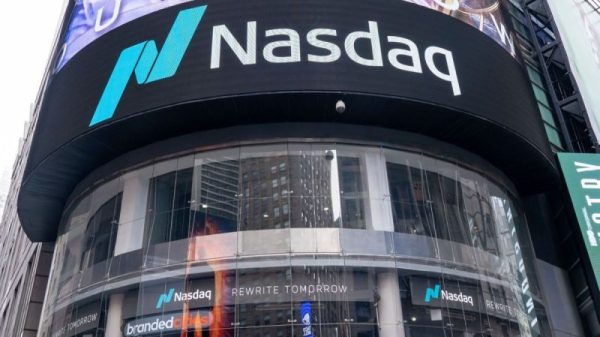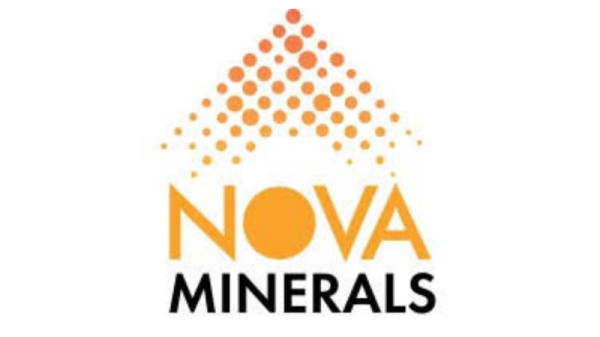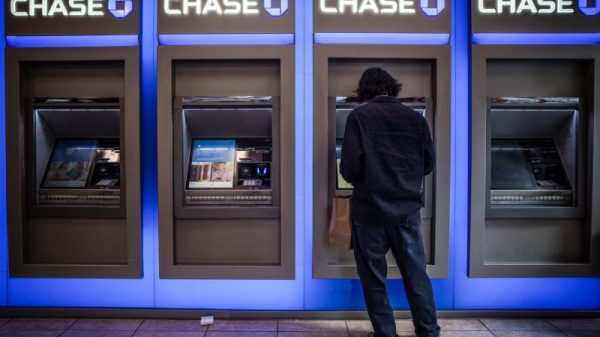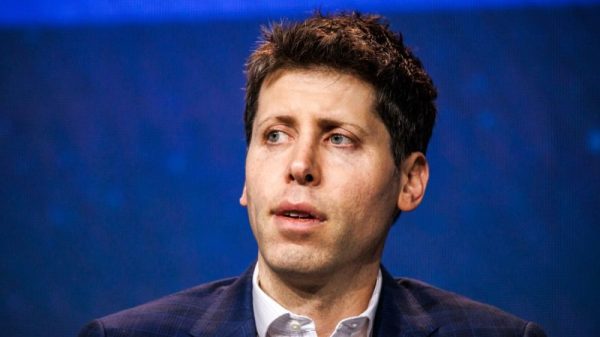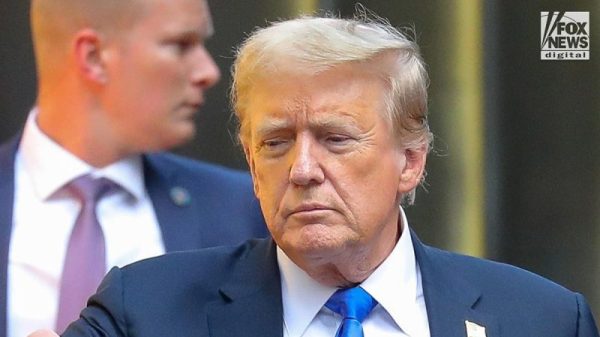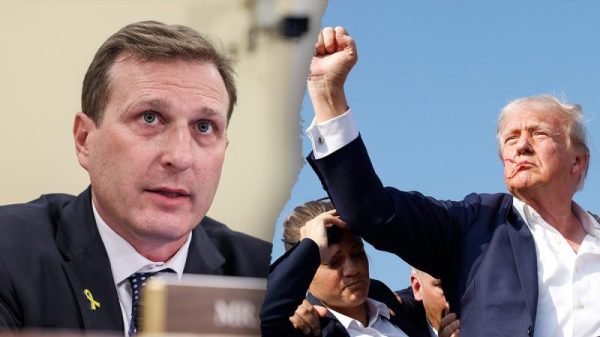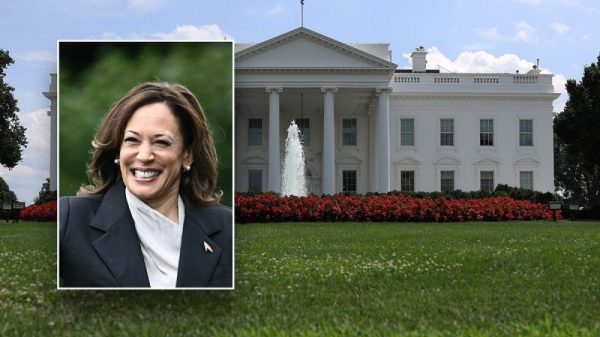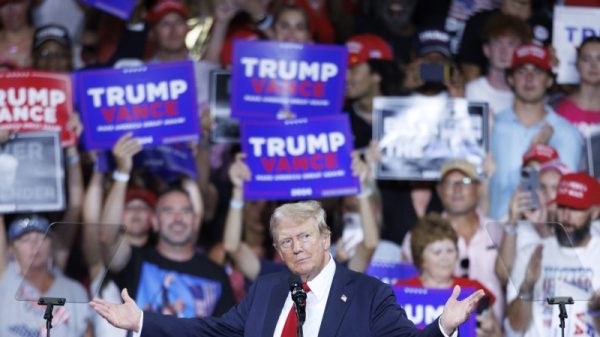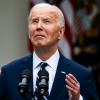Between the time that Republican presidential candidate Vivek Ramaswamy on Friday compared Rep. Ayanna Pressley (D-Mass.), who is Black, to a grand wizard of the Ku Klux Klan and the time he was confronted over that comparison on Sunday morning, there had already been two significant new developments in the national conversation about race.
The first was that civil rights leaders came to Washington on Saturday for an event commemorating the 60th anniversary of the March on Washington, the racial justice event during which the Rev. Martin Luther King Jr. gave his “I Have a Dream” speech. The second was that a White man walked into a store in Florida armed with a swastika-bedecked rifle and apparently targeted Black people because they were Black. Three people were killed by the gunman before he took his own life.
These two events sit near two poles of how race overlaps with American politics. The former is a manifestation of the institutionalized push for justice, a push that follows familiar beats in part because it is confronting familiar challenges. The latter appears to be a manifestation of the worst form that anti-Black racism can take.
Both are useful context for Ramaswamy’s comments.
When he announced his candidacy earlier this year, Ramaswamy invoked King and King’s speech on the mall in 1963.
“That was the speech where he said, ‘I hope my four children grow up in a country where they are judged not on the color of their skin, but on the content of their character,’” Ramaswamy said in a video announcing his candidacy. “That dream stuck with me. It meant something to me.”
In that video and since — including on CNN’s “State of the Union” on Sunday — Ramaswamy explained what that quote meant to him. In keeping with an inordinate amount of Republican rhetoric in recent years, the candidate sees King’s words not in the broader context of his full speech or the historic moment in which it was given but as a sort of Uno-reverse for the race card: that any recognition of racial disparities is at odds with King’s vision.
So, instead of addressing inequalities that are rooted in race, in this view, we should treat efforts to address those inequalities as hindrances to the universal racial harmony that will follow our ignoring race entirely. And instead of accounting for the ways in which success is hindered by racism, we should simply act as though contests for power are fair and celebrate the winners.
“Right as the last few burning embers of racism were burning out, we have a culture in this country largely created by media and establishment and universities and politicians that throw kerosene on that racism,” Ramaswamy told CNN’s Dana Bash on Sunday. “I can think of no better way to fuel racism in this country than to take something away from other people on the basis of their skin color. I have been saying that for years. And I think that is driving, sadly, a new wave of anti-Black and anti-Hispanic racism in this country.”
During last week’s presidential primary debate, Ramaswamy declared that “reverse racism is racism,” a statement that is very much at the heart of the appeal Donald Trump held for Republicans (and into which Ramaswamy has proven eager to tap). Republicans are more likely to see White people as targets of discrimination than Black or Hispanic Americans.
In part, that’s because of the new attention paid to the ways in which racism manifests in modern America. What Ramaswamy frames, usefully, as “throwing kerosene” on race might also be presented as an effort to draw attention to systemic disadvantages that non-White Americans face in getting jobs, buying homes or dealing with law enforcement. What Ramaswamy describes as “taking something away from people based on skin color” is obviously meant to refer to things such as affirmative action and not to Black people being filtered out of consideration for jobs based on their names. The entire point is that racism against non-Whites has been forced into more subtle patterns.
Unfortunately for Ramaswamy, he also decided to scoff at explicit racism on Friday.
“I’m sure the boogeyman white supremacists exist somewhere in America,” he said during a campaign stop in Iowa. “I have just never met him. Never seen one. Never met one in my life, right? Maybe I will meet a unicorn sooner. And maybe those exist, too.”
It’s useful to consider why Ramaswamy is downplaying the idea of white supremacy as a force in the United States. People like Trump and Tucker Carlson have extrapolated from “criticism of embedded racism that benefits Whites” to “criticism of Whites” to “portraying Whites as inherently racist.” By now, nearly a decade after the start of the “Black Lives Matter” movement, any allegation of racism triggers mockery on the right as necessarily opportunistic or insincere. So Ramaswamy, in his ceaseless effort to generate approval from his audiences, joins in the scoffing.
Then that guy in Florida had to shoot those people in that store. So, to Bash, Ramaswamy admits there’s anti-Black racism — but blames it on the way White people have purportedly been treated. If there is a throughline from efforts to address systemic racism to gunning down Black shoppers, it seems fair to suggest that perhaps the path includes opportunistic arguments that frame those efforts as attacks on White people and their status.
Ramaswamy is a student of right-wing rhetoric, obviously. For example, he pushed back on Bash’s questions about the shooting by suggesting that having respect for the victims necessitated “not bring[ing] them into partisan politics.” He also argued that it was the left who were the real racists, citing, as an example, tech journalist Kara Swisher calling him “Ramasmarmy,” something he said was “effectively reducing me to the color of my skin and my attributes.”
Then there was Pressley. What did she do to supposedly warrant Ramaswamy saying that she was using “the words of the modern grand wizards of the modern KKK?” She reportedly said, “We don’t need any more brown faces that don’t want to be a brown voice.”
“For Ayanna Pressley to tell me that, because of my skin color, I can’t express my views, that is wrong. It is divisive. It is driving hatred in this country,” Ramaswamy said. “This is dividing our country to a breaking point.” You may recall that, during the debate, Ramaswamy declared that the country was in a state of “cold cultural civil war.”
The political strategy here is the one Trump deployed in 2015. Cast the left and your opponents as deeply tainted and use the most strident rhetoric possible to describe them. If anyone pushes back, you double down and reframe as needed. Arguments don’t need to be consistent beyond “the left is bad, and the right are victims.”
Consider what happened after the discussion of race on “State of the Union.” Bash then asked Ramaswamy about climate change.
“The climate-related death rate, tornadoes, hurricanes, heat waves, it is down by 98 percent over the last century,” Ramaswamy said. “For every 100 people who died of a climate-related disaster in 1920, two die today. And the reason why is more abundant and plentiful access and use of fossil fuels.”
No, the reason is because weather forecasting is far more robust thanks to scientists and because we’ve learned better how to build to accommodate extreme weather. This also conflates “climate” and “weather” in a misleading way, but who cares? “Climate change is bad, and fossil fuels are good” is the point, just as “holding systems that benefit Whites to account is bad, and calling the left ‘racists’ is good” is the point.
If it weren’t for the fact that this new effort to bolster White grievance keeps overlapping with incidents of violence against non-White actors, Ramaswamy’s desperate efforts to appeal to the mostly White Republican electorate would barely be worth discussing.
But it does.



